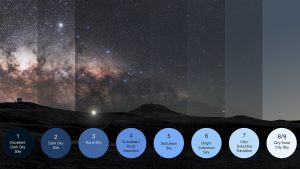
SourceL Wikipedia.
For amateur astronomers, one of the most important factors in observing the night sky is sky quality—specifically, how dark the sky is. The darker the sky, the more stars and deep-sky objects become visible. To describe this variation in sky darkness, astronomers use something called the Bortle Dark-Sky Scale, commonly known as the Bortle Scale.
What Is the Bortle Scale?
The Bortle Scale is a nine-level scale used to classify the brightness of the night sky due to light pollution. It was created by John E. Bortle in 2001 to help amateur astronomers evaluate and compare their observing conditions. Each level, from Class 1 (the darkest skies) to Class 9 (the brightest, most light-polluted skies), provides detailed descriptions of what the observer can expect to see, including visibility of the Milky Way, limiting magnitude (the faintest stars visible to the naked eye), and which celestial objects are observable.
The Scale at a Glance
Here’s a simplified overview of what each Bortle class represents:
Class 1 – Excellent dark-sky site
No light pollution. The Milky Way is incredibly detailed, shadows are cast by starlight, and even faint galaxies are visible to the naked eye.Class 2 – Typical dark-sky site
Very minimal skyglow on the horizon. The Milky Way is prominent, and structure is visible within it. Great for deep-sky observations.Class 3 – Rural sky
Some light pollution is noticeable near the horizon. The Milky Way is still quite impressive, though some faint stars are lost.Class 4 – Rural/suburban transition
Light pollution is more obvious. The Milky Way is visible but lacks detail. Many Messier objects are still observable.Class 5 – Suburban sky
The sky appears grayish. The Milky Way is faint and often invisible. Bright star clusters and some nebulae can be seen.Class 6 – Bright suburban sky
Light pollution washes out most of the sky. The Milky Way is not visible, and only the brightest Messier objects are observable.Class 7 – Suburban/urban transition
Sky has a noticeable orange or gray glow. Only a few of the brightest stars and planets are visible. Deep-sky observing is very limited.Class 8 – City sky
The sky is very bright. Only a handful of stars are visible. The Moon, bright planets, and maybe a couple of the brightest deep-sky objects can be seen with a telescope.Class 9 – Inner-city sky
Severe light pollution. The sky is often brighter than the celestial objects themselves. Observing is limited to the Moon and maybe Venus or Jupiter.
How to Determine Your Bortle Class
There are a few ways to estimate your local Bortle class:
Light pollution maps, such as those provided by the Light Pollution Atlas or apps like Clear Outside, can give you a general idea based on your location.
Visual observation is also key. Count how many stars are visible in the constellation Cygnus, note whether the Milky Way is visible, and record the color and brightness of the sky background.
Why It Matters
Understanding your Bortle class helps set realistic expectations for what you can observe. For example, if you’re in a Bortle 6 zone, you’ll struggle to see faint nebulae or galaxies—even with good equipment. On the other hand, if you’re traveling to a dark sky site rated Bortle 2 or 3, it’s worth planning ahead to observe objects that are normally out of reach.
As you gain experience, learning to adapt your observing techniques to different Bortle classes becomes part of the hobby. Whether you’re in your backyard or out at a dark-sky park, knowing your sky’s Bortle rating helps you make the most of your time under the stars.